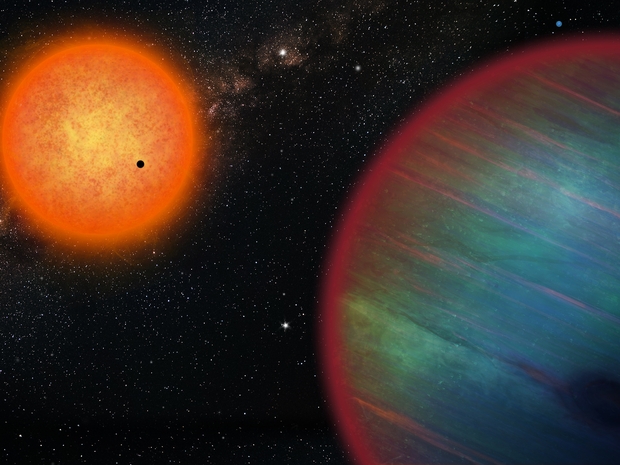What catches your eye in this description of an exoplanetary system? Start with a ‘hot Jupiter,’ with a radius 0.87 times that of our Jupiter and an orbit of 7.1 days. This is WASP-132b, confirmed in 2016, and first discovered through the labors of the Wide-Angle Search for Planets program. Subsequent confirmation came through the CORALIE spectrograph installed on the Euler telescope at the European Southern Observatory’s La Silla site. This world orbits a K-class star 403 light years out in Lupus.
The CORALIE measurements gave hints of another giant planet in a long period orbit. The system came still further into focus in 2021, when observations from TESS (Transiting Exoplanet Survey Satellite) showed a transiting super-Earth with a diameter of 1.8 Earth radii in a tight orbit of 1.01 days. The mass of the planet, as measured by the HARPS spectrograph at La Silla, is six times that of Earth. So we have both a hot-Jupiter and a super-Earth hugging the star, along with an outer gas giant.

Image: The WASP-132 system was known to harbour WASP-132b, here in the foreground, a hot Jupiter planet orbiting around a K-type star in 7.1 days. New data confirms the system has more planets, including an inner super-Earth, here seen transiting in front of the orange host-star. Visible as a pale blue dot near the top right corner is also the giant planet WASP-132d discovered in the outskirts of the system. © Thibaut Roger – Université de Genève.
While the European Space Agency’s Gaia satellite continues to take astrometrical data on WASP-132, follow-up work has shown the super-Earth to have a density similar to Earth’s and a composition of metals and silicates fairly similar to our planet (remember, we have both radius and mass measurements to work with because of the multiple datasets from different detection methods). Meanwhile, the problem here should be apparent.
Ravit Helled (University of Zurich) and a co-author of the study offers this:
‘‘The combination of a Hot Jupiter, an inner Super-Earth and an outer giant planet in the same system provides important constraints on theories of planet formation and in particular their migration processes. WASP-132 demonstrates the diversity and complexity of multi-planetary systems, underlining the need for very long-term, high-precision observations.’’
All true, of course, but it doesn’t get across how unusual this finding is. For hot Jupiters as thus far observed have been relatively isolated from planets further out in their systems. That makes sense because the model for their formation involves migration, with the giant worlds forming far enough out from the star to feed off plentiful gas and dust in the protoplanetary disk, and then moving inward as the system takes form. Woe to inner planets, whose fate might include ejection from the system entirely.
WASP-132 shouldn’t have the system architecture it does given this theory of migration, meaning we have to re-examine the nature of migration, or ponder ways to achieve a planet of this size in a tight stellar orbit that leave migration behind altogether. The hot Jupiter here leads François Bouchy (University of Geneva), a co-author of the study, to say this:
“The WASP-132 system is a remarkable laboratory for studying the formation and evolution of multi-planetary systems. The discovery of a Hot Jupiter alongside an inner Super-Earth and a distant giant planet calls into question our understanding of the formation and evolution of these systems.”
To my knowledge, WASP-132 is the second example of a planetary system in this configuration. WASP-47 takes precedence in terms of discovery, having been first analyzed by the WASP team in 2012 (discovery of the hot Jupiter) and then expanded through work with K2 data in 2015. WASP-47, a G-class star in Aquarius some 880 light years away, hosts a super-Earth inside the hot Jupiter’s orbit, a hot Neptune outside its orbit, and an outer gas giant (‘warm Saturn’) within the habitable zone. The discovery paper of the smaller worlds at WASP-47 is worth quoting:
The continued existence of the companions in this system indicates that HEM [high eccentricity migration] ] cannot serve as the sole formation mechanism for hot Jupiters. HEM would likely have disrupted the orbits of the smaller planets. It is quite possible that there is more than one potential formation mechanism for hot Jupiters. Additionally, recent observations have identified an additional Jupiter-mass planet in a 571-day orbit (called WASP-47c; Neveu-VanMalle et al. 2015) in this system, making this the first hot Jupiter with both close-in companions and an external perturber. Future dynamical work will place limits on the architecture of this system.
The paper is Thibaut et al., ”Discovery of a cold giant planet and mass measurement of a hot super-Earth in the multi-planetary system WASP-132′,” Astronomy and Astrophysics Vol. 693 (15 January 2025), A144 (full text). On WASP-132, see Becker at al., “WASP-47: A Hot Jupiter System With Two Additional Planets Discovered by K2,” Astrophysical Journal Letters Vol. 812, No. 2 (12 October 2015), L18 (full text).



I am having trouble imagining what it would look like to stand on the surface of the Super Earth. (Of course you would probably need a spacesuit!
Well, given its mass and size it’s likely to have up to 10 times the Earth’s surface gravity, so the first thing you are likely to want to do is to lie down.
Orbiting at 2.7 million km, its sun would subtend about 22 degrees in diameter, so you don’t want to be on the day side. Of course, that close, and with an orbital period of 1 day, it’s highly likely to be tidally locked, so you could maybe find a spot just near the day night boundary to lie on your lounge chair and see a little of the star, but not get fried. Alas, you are not likely to survive the experience, assuming the surface gravity really is 10 g’s.
I don’t see any physics that support the idea that a gas giant has to migrate. I think form in situ and their migration is based on an obsolete idea that gas giants have to form beyond the snow line. It’s the random distribution of gas in the interstellar protoplanetary gas cloud. Also the size of the gas cloud and gas and dust distribution is based on the side of the star, for the larger the star the gravity and the bigger the system which also gives the size of the solar system. This idea of course is a generalization which might have some exceptions, but a larger solar system with a G class star like our own might have more possibilities of collisions and giant impacts which is why we should look at G class stars if we want to find another Earth Moon system with gas giants as the outer planets.
“The continued existence of the companions in this system indicates that HEM [high eccentricity migration] ] cannot serve as the sole formation mechanism for hot Jupiters.”
I also have to wonder how that high eccentricity originates. That is not a property of the original stellar disk. It would have to be a common mechanism since it seems to occur so often. Further, if the migration is by accretion disk “friction” that would affect the smaller planets far greater, likely leading to them being absorbed into the star.
Maybe I’m misinformed, but giant planet migration has never made much sense to me.
An old CD post explaining how a gas giant can migrate inwards.
https://www.centauri-dreams.org/2014/09/16/hot-jupiters-explaining-spin-orbit-misalignment/
There are are also a number of CD articles noting how hot Jupiters are drier than their cold sisters. I didn’t read them to discover that this was due to loss of water after migration, or whether this was due to perhaps place of formation and not migration.
There are other articles on planet migration on CD, and no doubt scholarly articles on the web too.
Alex, I’m aware of that explanation. However, these types of planets are quite common and the required specific third party interactions are not so common. It’s an attractive idea don’t doesn’t appear to explain the observations. Of course I could be wrong since I don’t follow the subject closely.
According to Google AI the gas giants migrated hundreds of millions of miles during their formation as they collected gas and dust from the accretion dust from the protoplanetary disk. The ice giants, Uranus and Neptune moved further out.
The gas giants still have to have a starting point and the size of the solar system, star and gravity still are important. A smaller system might have more hot Jupiters. I still think that in situ formation matters considering how the density and mass is distributed throughout the proto-planetary spherical gas cloud which collapses into a disk due to the centrifugal force keeping the gas cloud flat and disk shaped since the gas can collapsed vertically but not horizontally due to the centrifugal force controls the starting point of gas giant formation, but the end point including the migration. I stand corrected.
excuse me, I forgot to put in the not in my sentence, “but not the ending point including migration which is controlled by other processes: angular momentum from the gravitational accretion of dust and gas, torque, disk viscosity, density waves. Open AI Chat GPT source.
This system has a lot of similarities to the 55 Cancri system.
Wasp 132 55 Cancri
132c 8 EM 1d period 55e 6 EM 0.7d
132b 0.4 jup 7d period 55b 0.8 jup 14d
55c 51 EM 44d
55f 48 EM 259d
132d 5 jup 1816d period 55d 6 jup 5500d
E = 0.12 E=0.13
Both systems have gas giant-sized planets with a dense super-Earth inside them. Martin Fogg’s paper on Jupiter migration inwards had as a consequence of his simulations the Jupiter-sized planet aside from scattering planetismals, it also tended to bulldoze them inward, collecting them into a super Earth in a very tight orbit.
However, if we look at the 55 Cancri system there doesn’t appear to be much evidence for much inward migration. Both these systems appear to be unique in that very massive planets formed close to their star. These could be accounted for if both stars were high carbon stars. In high carbon stars, the excess carbon condenses into graphite dust rather than CO, so the inner nebula would have a large mass of graphite dust, which condenses out at temperatures that vaporize anything else. Planetismal formation scales in proportion to orbital distance so this dust would quickly condense into planets.
A high angular momentum/rotational speed might also be the cause, the gas and dust piling up in a tight orbit near the protostar while it shed angular momentum.
Both systems appear to have a snow-line Jupiter much like out system.
“While the European Space Agency’s Gaia satellite continues to take astrometrical data on WASP-132…”
Not after January 15th – the Gaia spacecraft has reached end of life, and data acquisition has stopped as of that date.